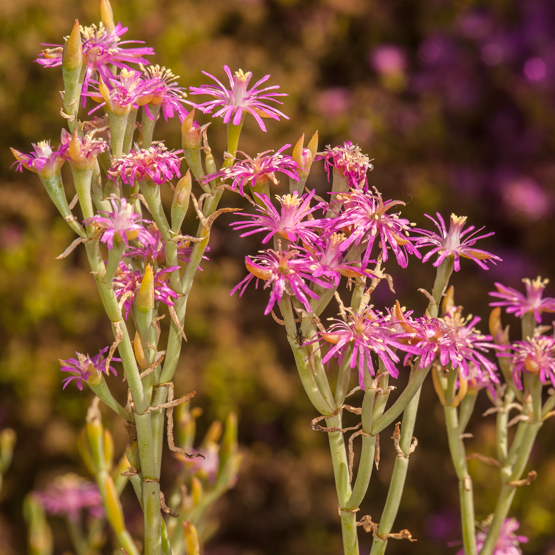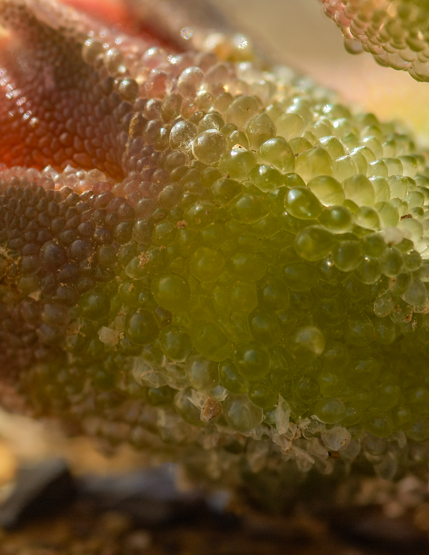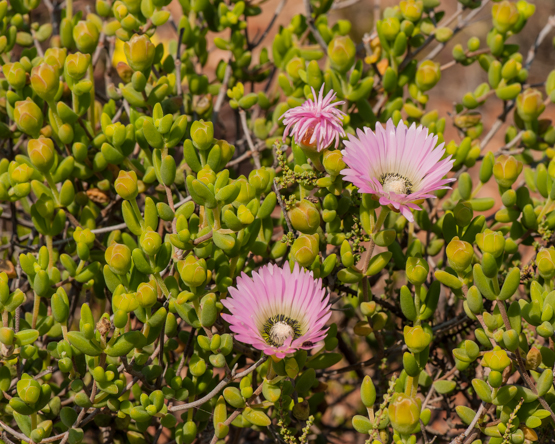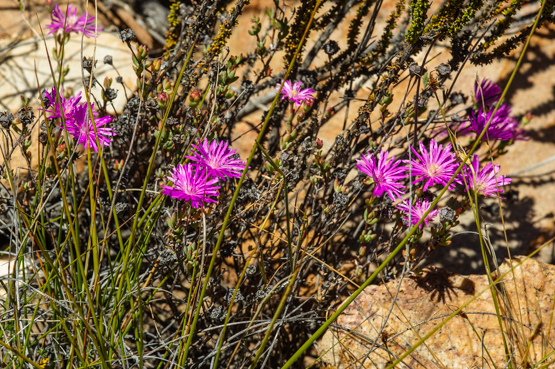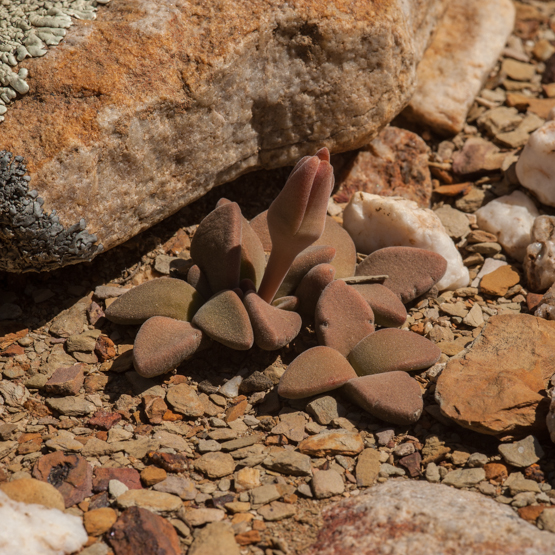Almost all Mesembs are leaf succulents, but this species is an exception.
On young stems, leaves are present for a short period, but they fall off as soon as the dry period sets in. The leaves are small but at the same time quite succulent. One would think it to be wasteful to invest a lot of energy in producing something that is used for only a short while. Nevertheless it seems to be a successful strategy, as the species is widespread and often locally abundant. They act as pioneers on disturbed loamy soils and that probably explains how they can afford to be wasteful with their resources. The disturbance will in most cases aerate the soil and make nutrients available, so that for some time food is present in abundance.
The plants may be up to 60 cm tall and occur from Namaqualand to the Eastern Cape.
The flowers are white, pink or purple, up to 1.5 cm across and appear in spring (September- November).
Tag: vygies
Mesembryanthemum guerichianum (2)
The big bladder cells that cover leaves and calyxes give the impression of beautiful jewellery, but their reason for being there is rather more prosaic. They function as external water storage for the plants (see post 17 Dec. 2012).
Mesembryanthemum guerichianum (1)
Trichodiadema mirabile
The genus name is derived from Greek trix = hair and diadema = crown. This refers to the tuft of stiff hairs or bristles present on the tips of leaves and sepals.
The diadem is believed to be able to absorb dew and rain water. This idea is supported by the fact that in cultivation, where there is usually much more water available to the plants, the diadem is often not well developed.
The crown of hairs can be removed as a whole and is the most characteristic property of the genus. In spite of this, diadems are not present in all species, nor do they all look the same. In most cases the diadem consists of radiating hairs, but in a few species the diadem is a tuft of erect bristles. T. mirabile is a case in point.
The species forms an erect shrublet up to 8 cm tall. The beautiful, pure white flowers are up to 4 cm in diameter and appear from October to January.
The plants can be found on stony slopes from the Laingsburg area to Uitenhage.
Ruschia caroli
In spring (August-September), this is one of the many Mesemb species decorating the countryside with their colourful flowers.
It occurs from my area northwards to Clanwilliam on sandy and clayey soils.
The shrubs are up to 60 cm in height and 80 cm in diameter, with decumbent* grey to reddish branches (* creeping on the ground with the tips curved upwards).
The flowers are 2-2.5 cm across and pink to magenta with a darker midline.
Looking at the pictures you will notice that the last one gives a rather different impression of the flowers. It was taken in the shade and very slightly overexposed. This combination gives a result that I find rather pleasing to the eye.
Drosanthemum speciosum, decked out with yet another colour
“After three consecutive posts on one species, I will not mention it for a while now. Promise.”
I wrote this in October last year and the species I referred to was the same one as the subject of this post. After being silent on the topic for some ten months, I now have reason to bring it up again.
Last Sunday I visited “Vrolykheid Nature Reserve”, which is situated between Robertson and McGregor. The plant pictured here was only one of a couple of interesting finds this little known reserve proved to have in stock.
When I had a look at some plants of Drosanthemum speciosum with very dark scarlet flowers, I suddenly noticed one plant with exquisite silvery pink flowers. In all other respects it looked like a run-of-the-mill D.speciosum. Nevertheless I checked out all my available literature and found out that the flower colour is described as “red to orange” and” bright orange to crimson”.
The only book with a different opinion is “Vygies, gems of the veld” by Van Jaarsveld en De Villiers Pienaar. What they say is the following: “Flowers up to 50 mm in diameter, usually orange, flaming scarlet or red. There are however yellow, rose-pink and even pale pink or straw-coloured forms of the plant.”
There is a similar species with pink flowers growing near Ceres (D. bellum), but there the leaves are more or les cylindrical and recurved at the tip, whereas in D. speciosum the leaves are “semi-cylindrical or trigonous, incurved like horns”.
Braunsia apiculata
With only five species, Braunsia is one of the smaller genera in the family Aizoaceae.
B. apiculata can be distinguished by its velvety leaves with a recurved, dark, sharp tip (apiculate= abruptly ending in short, spine-like tip).
The showy flowers (about 4 cm in diameter) appear from July to September.
The species is widespread from the Ceres Karoo and Cedarberg Mts. to the western Little Karoo, mainly on sandstone outcrops and shales.
Ruschiella argentea (2)
Ruschiella argentea (1)
In 2005, Cornelia Klak set up the genus Ruschiella to accommodate a couple of species of Lampranthus.
Up to then, the subject of this post was known as either L. argenteus, L. montaguensis or L. nardouwensis. The plants are shrublets up to about 25 cm tall, with greyish green leaves 17-20 mm long. The flowers are 19-23 cm across, with white to pinkish purple petals which have a more or less distinct mid stripe.
According to literature, the species occurs from Clanwilliam to Paarl and Montagu. The pictures in this post show that plants grow much further east, around Calitzdorp, but probably also belong to this species.



